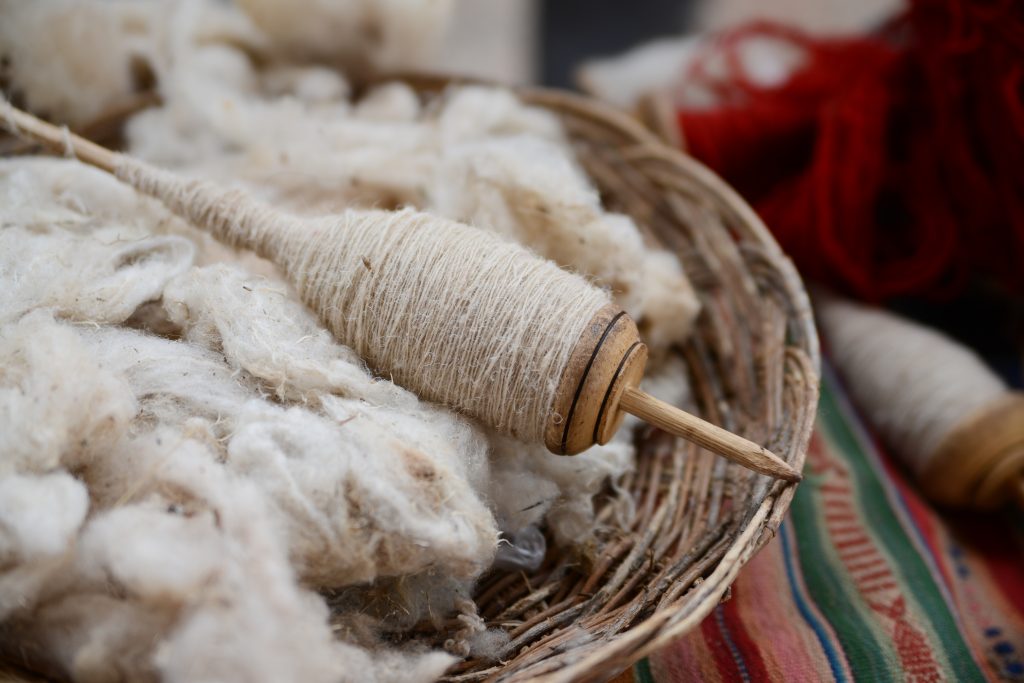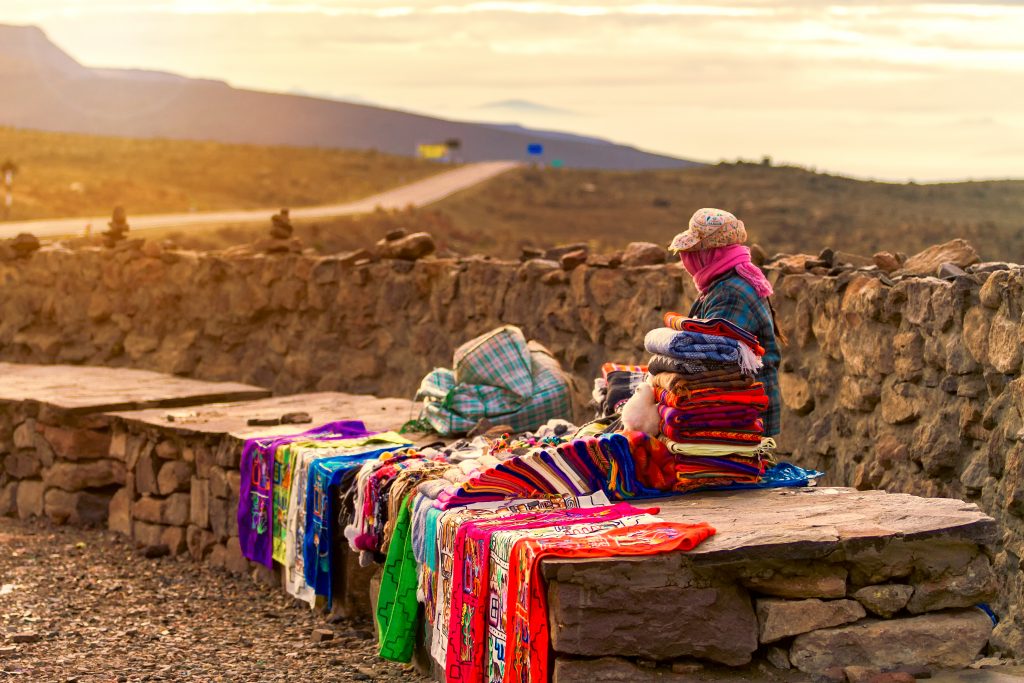Best Places to Buy Quality Alpaca-wool Clothing in Peru
Discover the best places to buy quality alpaca-wool clothing in Peru and bring home an exceptionally unique souvenir from the legendary Andes
Alpaca-wool clothing is one of the most popular souvenirs to bring back from a tour of Peru. There really isn’t anything else that simply screams ‘Peruvian Andes’ like a distinctive colourful sweater woven with some of the world’s most prize wool.
Modern, versatile, deliciously warm and oh-so-authentic, the Made in Peru high-quality garments are found all over the country, although quality and array of designs can vary considerably depending on where you shop.
Whilst mass machine-made garments – including scarves, beanies, gloves and socks – can seem a ‘dime a dozen’ after just a week of local-market crawling, you’ll find plenty of special places where artisans produce and sell stunning pieces woven by hand using ancient techniques. It’s for seekers of these high-quality clothing pieces that this guide has been designed.

The best places to buy quality Alpaca-wool clothing are primarily found in the capital, Lima, as well as Cusco and Arequipa, two high-Andean cities that are revered for their Alpaca-wool production.
No matter where in Peru you travel, you’ll find locals striving to preserve and promote what is, to them, an ancient cultural practice and you should know that bringing home quality alpaca-wool clothing from here is not just about buying a souvenir.
It’s about bringing home a piece of the country’s most fascinating history.
The history of alpaca-wool clothing in Peru
Unlike what many may erroneously believe, alpaca-wool clothing in Peru isn’t a new fad but rather a revered practice that was perfected over several centuries before the Spaniards even arrived.
The ancient Incas of Peru were so enamoured with alpaca wool that, by the time Europeans arrived, they had already selectively bred animals to ensure the finest fleece would be produced. So exclusive were the garments, that only members of the royal family were ever allowed to wear them. So precious was the wool, that only the royal family was allowed to use it to weave tapestries and rugs.
When European conquistadores arrived, they were (quite literally) blinded by the gold and silver reserves they found and proceeded to loot Inca riches without realizing that, to the Incas themselves, these were materials for mere decorations.
What they valued most, in fact, were their stocks of fine alpaca, vicuna, guanaco and llama wool, each one obtained from specially-bred animals. The irony of this lack of understanding meant that European settlers gave little thought to herds of native animals they encountered, effectively bastardising breeding lines and bringing an end to what was once an ancient and revered Inca artisan tradition.
Fast-forward to today and Peru’s best alpaca-wool is still considered among the finest in the world although experts believe the quality is still nowhere near as exquisite as it was during Inca times. So coveted is the wool, however, that alpacas have been exported for breeding and farming all over the world.
An estimated three million alpacas exist in countries as far afield as Australia (home to more than 350,000) yet over 94% still live where they always have: happily grazing in the highlands of the South American Andes.

Alpaca wool naturally comes in about 20 distinct shades, most of which are then dyed to demand. The fibres are primarily classed by thickness, with the finer fibres resulting in the softest wool.
For this reason, the most coveted wool is produced by the very first shearing of a baby alpaca. On international markets, a kilo of alpaca wool can fetch about $25 USD, about six times more than sheep’s wool yet one one-tenth (or even less) the price of vicuña wool, which is made from the alpaca’s smaller cousin and considered the rarest and most expensive natural fibre in the world.
Whether you wish to take home a token garment as a present or make a lovely investment as a reminder of your fantastic adventure in Peru, buying alpaca-wool clothing is a rite of passage for every visitor.
Yes, you can buy a maybe-alpaca-wool hat for $5 at any market in Peru or invest $50 on an authentic, 100% alpaca-wool hat, from a recognised reseller, that’ll last a lifetime!
Shopping for quality alpaca-wool clothing in Peru
Many of the clothing and textiles found in tourist market stalls all over Peru are made of alpaca and regular-wool (or even synthetic) mixes, which is fine as it makes the garment cheaper, as long as that’s what you seek.
When it comes to quality garments, you’ll want to spend a few extra soles to buy 100% alpaca wool, which is softer (and colder) to the touch and won’t smell of drenched donkey when wet!
Our favourite shops sell world-class products, many of which are exported abroad and sold for several times their original price. In Peru, a great quality alpaca-wool clothing piece can sell for hundreds of dollars depending, of course, on style and colour. A unique souvenir such as this should be considered an exceptional investment and an unforgettable souvenir indeed.

Cusco – the textile capital of Peru
Renowned for being home to some of the best textile artisans in all of South America, Cusco is the heart and soul of Peru’s textile industry although the sheer concentration of low and mid-range market stalls and shops means you’ll need to know where to go to find exceptional, authentic, 100% alpaca wool garments.
Cusco is the best and most obvious shopping destinations in Peru, considering this is the base town for visits to Machu Picchu, the #1 “must-see” of just about every visitor to the country.
Many prized indigenous weavers around Cusco make fantastic and high-quality garments and are sold in the town’s more upmarket boutiques. Visit the Centro de Textiles Tradicionales del Cusco (in front of Jardin Sagrado in Avenida el Sol) where you can learn more about the history of weaving in Peru, watch daily weaving demonstrations and bag a stunning piece of 100% alpaca-wool clothing in the museum shop.
This non-profit organization promotes the sustainable practice of ancient weaving whilst supporting local craftsmen and women. Head to trendy San Blas, where the whole Carmen Alto shopping strip is brimming with high-end boutiques, and pop into Lamaland, which admittedly sounds more like a kitsch amusement park than a respectful boutique!
This relatively new concept store sells uniquely modern hand-woven alpaca-wool clothing as well as distinctive souvenirs you simply won’t find anywhere else. Alpaca Hand Knitwear Montse Badell is another treasure not to be missed in Cusco. The store is owned by a family who produce their own wool on their property near Lake Titicaca and sell their hand-knitted beauties in their store on Calle Palacio, just one block east of Plaza Mayor.
Discover all the best things to do in Cusco
Lamaland@Facebook

Lima, the capital
The obvious first choice is not necessarily the best choice in Peru; however, this is mostly related to price. Lima is a brilliant shopping destination and, being such a grand city, boasts far more markets and boutiques than Cusco does. However, most high-end quality alpaca-wool garments actually come from Cusco’s esteemed weavers and that’s what makes shopping in the capital marginally more expensive.
If, however, you have less time in Cusco or are now in Lima with just a few days left of your trip, fear not! You can still shop like pro and bring home a unique piece of authentic Peruvian clothing. Besides, considering the fact that Cusco is so affordable, buying alpaca-wool clothing is still cheaper in Lima than anywhere else outside of Peru.
Miraflores and Barranco are the best suburbs for quality shopping in Lima, with internationally-famous stores like Kuna boasting their largest store in Miraflores (as well as a small outlet at the airport and several in town centre) and Sol Alpaca offering gorgeous shopping experiences of quality items.
Barranco, on the other hand, is the latest gentrified suburb to pop up in Lima and swiftly regarded as the city’s trendiest address. Here, you’ll find more distinguishing shopping choices, such as Dedalo – essentially a ‘mini shopping mall’ held inside a renovated mansion, where each room is a dedicated boutique.
In Artesanias Portico, another beloved Barranco institution, you’ll find arguably the most colourful collection of alpaca-wool clothing in all of Lima.
Discover all the best things to do in Lima

Arequipa, the white city of Peru
It’s not often one gets the chance to pet the animal and buy a piece of clothing made from its wool, but in Arequipa that’s precisely what you can do. For a unique and all-encompassing alpaca-wool appreciation experience, head to Mundo Alpaca, just a short walk from the Santa Catalina Monastery.
Here, you can learn all about the ancient art of alpaca-wool weaving, straight from the alpaca’s mouth! Feed and pet the adorable beasts, visit the fascinating museum and shop for quality clothing in the museum shop. A 3-in-1 that’s not to be missed.

Whilst Cusco, Lima and Arequipa are indeed the best places to buy unique, high-quality alpaca-wool clothing, you’ll also find a kaleidoscope of fun, bustling markets in every main city and town of Peru. Most of the time, the items sold at markets won’t be of superb quality but, being much more inexpensive, means you can fill up the suitcase with great souvenirs your family and friends will absolutely love.
For brilliant tours of Peru that are as distinctive and unforgettable as the country’s best alpaca-wool clothing, check out our Signature Peru itineraries.

Talk to one of our experienced Destination Specialists to turn your Antarctic, Arctic and South American dream into a reality.
Contact us